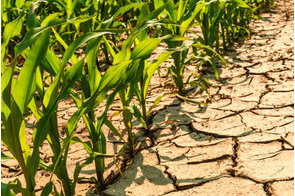Tackling the menace of weeds in organic farming

Summary
The availability of more healthy foods grown in environmentally-friendly manner can be significantly increased if highly-efficient methods of weed control are developed for organic agriculture.
I walked happily into my farm one bright Saturday morning, hoping to see neat rows of herbs smiling back at me. I was immediately overwhelmed at the sight of the weeds that had almost taken over the farm in the space of three weeks. At the beginning of the month, I had invited workers to weed the farm. But alas, the weeds were back at full tilt. I remember wishing I had a magic wand that I could swing in the air to make the weeds disappear and never come back.
The situation at my organic farm was hardly unique; neither was the frustration I felt. The reason is simple; clearing weeds from an organic farm is not cheap, especially when it is done manually. It requires hiring labourers whose wages are determined by the size of the farm and the thickness or height of the weeds. It is also a time-consuming exercise to clear weeds manually. Owners of organic farms like me insist on taking a lot of care in the process of weeding because we do not want to lose crops along with weeds. It is often the case when machines are used for weeding that some original crops would inadvertently be removed together with the weeds.
In tropical regions, weed control is a really big deal for organic farmers – those who practice the system of crop and animal production that does not involve the use of synthetic pesticides, fertilizers, genetically-modified organisms, antibiotics and growth hormones. Organic farmers yearn for the rainy seasons. However, regular downpours mean more weeds to deal with. Without using herbicides, committing time and spending money to manage weeds on several acres of land is really tough. In conventional farming, a single spray of herbicide can keep weeds away for a couple of months.
Weed is any plant that grows where it is not wanted. Weeds compete with crops for resources such as sunlight, water, soil nutrients and space, while serving as host plants for pests and diseases. They can be very aggressive competitors and can alter the growth of crops, thereby reducing yield and crop quality. Examples of weeds found in Nigeria and some parts of Africa include the Bahama grass, elephant grass, African Olive, Buffalo grass, African Club moss, among others.
Weeds have huge negative impacts on crop yield. They can reduce rice yield by as much as 60-70 percent, while reducing the yield of sugar cane by 20-25 percent. Weed competition can cause 27-77 percent reduction in the yield of soybeans and about 40-50 percent loss of grain yield can occur in wheat production as a result of weeds.
Many farmers worldwide are switching to organic method of farming. In fact, as of 2019, the Research Institute of Organic Agriculture (FiBL) and the International Federation of Organic Agriculture Movements (IFOAM – Organics International) said there are a total of 2.9 million organic producers around the world. The number of organic farmers is on the increase because of an increased awareness about the environmental and health implications of the widespread use of agrochemicals. Some herbicides can even destroy crops together with weeds. In some cases, the use of herbicides can cause certain weeds to dominate farmlands as they develop resistance to the herbicides.
Before the advent of chemicals, several methods were adopted by organic farmers to control weeds. One of such methods is mulching. Mulching is the process of covering the soil surface with certain materials to block light transmission to the soil and prevent weed growth. Organic materials such as wood shavings, straw and bark of trees, which are biodegradable, can be used as mulches. Non-biodegradable materials such as plastics, thick black polythene and weed barrier are also used in mulching.
I tried some of these methods. But based on my experience, weeds usually find their way through these materials eventually. At a point, my ground covers were buried by weeds. To be sure, the ground cover method I saw in the United States seemed to work well in controlling weeds. But it failed when I used it in Nigeria. The reason could be climatic differences.
Another weed control technique – although I have not tried it on my farm – is the stale seed bed technique. Some farmers use this method to get rid of weeds before the actual seeds are sown. The method involves leaving the tilled soil for a period of two to three weeks to allow the seeds of weeds in the soil to germinate after which they are pulled out and destroyed. Through this process, there is the possibility of eliminating most of the weeds that could hinder crop growth before the seeds are planted. Unfortunately, this method also has limitations because weeds have many ways of dispersal, the most common being wind and water.
Seeds of weeds can be blown to far distances by strong wind, thunderstorms or hurricanes. Weeds dispersed by wind include tridax, goat weed, milkweed, horse weed and rocket larkspur. Some weeds whose seeds are dispersed by water to wetlands are pigweed, purple loosestrife, docks and blue flag iris.
Animals and humans are also agents of weed dispersal. For example, animals with fur or hairy body can move around with weeds unbeknown to them, transferring them from one point to another. Human beings can as well transport weeds and their seeds as they move seeds for planting, and other items for use on farm. Many weeds have hooked spines or sticky hairs that help them cling to animals and humans.
Although traditional methods of weed control are often used in organic farms, more efforts need to be channelled into ensuring effective management of weeds, separately or in addition to mulching, crop rotation, cover cropping and good sanitation. A concept for weed management and/or control that is becoming popular entails the use of allelopathic plants.
Allelopathy occurs when certain plant species release toxic chemical substances into the soil and their environment, thereby inhibiting the growth of another plant. The idea deriving from this phenomenon is to include allelopathic plants in a crop rotation or intercropping system to provide non-chemical mechanisms for the control of weeds.
A typical example of plants with allelopathic property is sunflower (Tithonia diversifolia). Extracts from the stalk of sunflower have been demonstrated by researchers to effectively prevent the germination of weed seeds. Other plants exhibiting this attribute include alfalfa, animal ryegrass, red clover, oats, barley, carrot, among others.
Allelopathic plants can have varying effects depending on the plant and growth stage of plants growing around them. It is, therefore, important that more research is done in this area to ascertain the kind of neighbouring plants or weeds these allelopathic plants can suppress. Such research will seek to obtain specific compounds responsible for their bio-herbicidal effect or the retardation of growth in other plants.
Furthermore, compounds from such plants could be engineered to enable selective target of weeds to prevent a detrimental effect on original crops. That way, even in the absence of allelopathic plants, bio-herbicides developed from their active agents can be used to effectively manage weeds on organic farms.
Apart from bio-herbicides, farm equipment and machineries with higher precision for removal of weeds could help remove weeds without uprooting original plants or crops. It is also important to make such innovations available and affordable for farmers in developing countries.
The availability of more healthy foods grown in environmentally-friendly manner can be significantly increased if highly-efficient methods of weed control are developed for organic agriculture. Without doubt, more organic crop producers will come on board if lasting solutions to the menace of weeds on organic farms are developed.
Financial Nigeria Columnist, Mojisola Karigidi is a Nigerian biochemist and the founder and product developer at Moepelorse Bio Resources. She is also a Global Innovation Through Science and Technology (GIST) awardee, and an Aspen New Voices fellow.
Related
-
Reforming Africa’s urban food markets
The scale and success of Africa’s response will depend on the effectiveness of today’s solutions for ...
-
Helping farmers build resilience to climate change
Farmers all over the world are in dare need of crop varieties that can grow and thrive in their changing environment.
-
How to create wealth through agriculture in Africa
While both the employed and the unemployed across Africa have been encouraged to engage in agriculture, the focus has been ...







